 Networks - Cross cable
Networks - Cross cable
 Networks - Cross cable
Networks - Cross cable
|
On 10BaseT and 100BaseT networks, computers are connected together through hubs and switches. These devices are often expensive and pretty useless when we just want to connect two computers. The easiest solution then consists of using what we call a cross cable (to be compared to the straight cables we use with hubs).
The RJ45 connector is the connector we use in the 10BaseT and 100BaseT standards to connect cables to network devices. It looks like this:

The pins of the RJ45 connector are numbered, considering it is upside down (clip down):
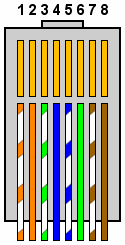
The picture above also shows the colours of wires we commonly use for cables with RJ45 connectors.
A straight cable (used to connect computers to hubs) are easy to make: it made of 2 RJ45 connectors cabled with the same colours as those shown above.
A cross cable for a 10BaseT (10 Mbps) network has a RJ45 connector cabled as shown above and another one cabled as shown below (clip down):
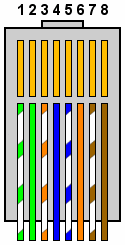 |
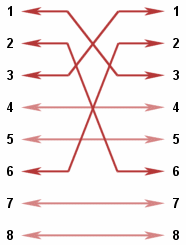 |
Pins 4, 5, 7 and 8 are not crossed.
On the other hand, a cross cable for a 100BaseT (100 Mbps) network has its second RJ45 connector cabled as shown below (clip down):
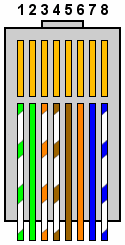 |
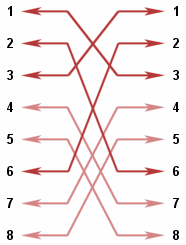 |
Note 1: pairs 4-5 and 7-8 are not used on 10BaseT networks (they are connected to the ground); crossing them does not matter. Therefore, we can use cross cable for 100BaseT networks on a 10BaseT network. On the other hand, the opposite may not be true (see next note).
Note 2: it is possible to use a 10BaseT cross cable on a 100BaseT network, but only if it has been made with a category 5 cable. All things considered, it is then a good idea to always make cables for 100BaseT, as they can be used both for 10BaseT and 100BaseT networks.